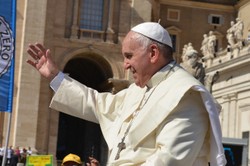Think of meditation and it is likely that you think of a person performing a yoga pose and emptying their mind, possibly to the sound om. This is Eastern meditation and belongs to religions of the Indian tradition, such as Hinduism, Buddhism and Jainism. But there is a different tradition in Christianity that has been neglected in recent years. In Christian practice meditation can develop into a stage of prayer higher than meditation, which Christians call contemplation or mystical prayer.

Christian meditation
by frankbeswick
Christianity has its own meditation techniques which have not been as well popularised in recent years as the techniques of eastern faiths have been.
The modern state of affairs
in recent years meditation has acquired a reasonable degree of popularity in the West. It began with the hippy movement and the Beatles' visit to India to learn transcendental meditation from the Maharishi Yogi. Zen Buddhism has enjoyed some popularity in parts of America and Europe. These developments are due to the fact that in the modern world faiths are no longer restricted to specific areas, and you can find a wide range of religious beliefs in any part of the world, except totalitarian states where religion is suppressed, such as North Korea, and Islamic states such as Saudi Arabia.Within two miles of my home in satellite town of Manchester, England, I can find two Buddhist meditation centres and a Hindu temple.There are Sufis a little further away, practising their own meditation techniques. Each religion has its own techniques of meditation that rise out of its particular view of the world. There may be overlaps between meditation techniques, but there are differences.
Christian mediation is focused on the Christian's relationship with God, who may or may not disclose his presence in prayer. The Christian meditator may focus on the idea of God or some particular aspect of his character, or he/she may focus on Christ, thinking about an event in his life. Others may focus on a saint's life or a particular virtue, especially one that they lack. There are therefore several techniques of meditation available to the worshipper.
meditation
 | Christian Meditation: Your Daily Practice A concise handbook by a highly respected meditation teacher. Written in the tradition of John Main, the pioneer who revived the Christian tradition of meditation, this book is a... |
 | Christian Meditation: Experiencing the Presence of God Enter a Monastery Without WallsChristian Meditation introduces an ancient practice to a contemporary audience. James Finley, a former monk and student of Thomas Merton, presents... |
Silence
The first condition of meditation is silence. In Christian thinking silence is the time when the gentle, quiet "voice" of God is heard. This is why in Christian religious institutions after lights out they have a practice known as magnum silentium, the great silence, which lasts until after morning prayers. During the night the monk is expected to focus on religious matters in the silence provided by this institution.
Silence is the reason why many meditators have sought out lonely places. Hermits used to find secluded spots to meditate, and thus some would seek lonely islands to perform their hours of prayer. The Trappist monks, a branch of the Cistercian order, have a rule that speech is only to be used when necessary, and much of their day is spent in silence. The Carthusians, who spend their day in their cells, studying or at prayer, except for the afternoon work, spend most of their lives in silence when they are not at services.
The silence on the outside is merely the tool for the inner silence which Christians believe to be essential to meditation. For Christian meditators the absence of external noise is a tool towards the attainment of inner stillness. This stillness involves the calming of the emotions and uncontrolled thoughts. These can be stirred by external distractions, and so avoiding distractions is important for meditation. However, controlling thoughts that can be impulsive and intrusive is never easy and takes a great deal of self-discipline and practice. No one said that meditation was going to be easy.
All this having been said, some meditators require a stimulus. This is often literary, in the form of Scripture, but it is possible that some are inspired by music. Certainly, Catholic plain chant is designed to calm the emotions, and having heard this at some time during the day is means by which a person can approach the state of inner stillness that is necessary to meditation.
 | Silence Unfortunately, today the ascetical part of our spiritual life does not have many admirers, still less, followers. Many would like to reach the peak of perfection in a very short... |
 | A Book of Silence In her late forties, after a noisy upbringing as one of six children and adulthood as a vocal feminist and mother, Sara Maitland found herself living alone in the country and, t... |
 | Silence: The Mystery of Wholeness With its beautifully rich prose, Robert Sardello's newest book invites us to experience silence as a companion presence, a creative heart-felt experience that renews, restores, ... |
Christian techniques
It is important to realize that body posture is a matter of disagreement. Some people happily take up the techniques of yoga, but other Christians do not feel that posture is important. The posture to be taken varies with the individual and there are no hard and fast rules. Any position in which one is comfortable is sufficient.
Secondly, certain eastern practices have no place in Christian meditation. The sacred syllable om has no part in Christian meditation. It belongs to the Hindu philosophy and is believed to be the sound that reflects the fundamental presence of the divine in the universe. It is not that Christians reject om, it is that the sound has never had a place in Christian religious thinking and no spiritual tradition uses it. Furthermore, emptying one's mind to think of nothing is not the aim of Christian meditation. The aim is to empty the mind so that one can focus on thoughts of God and maybe, if one is fortunate, in his presence.
One technique which is recommended for less experienced meditators is taking a prayer, such as the Lord's Prayer and reflecting in its meaning, line by line or phrase by phrase. This provides a structured way of reflecting with a constant stimulus. Another technique is to take a Bible story and compose the scene in your mind, spending time reflecting on it. This is again useful as it provides a stimulus. Reflecting on scenes from nature is another way of thinking on the works of God. Another version of this is meditative reading, in which the stimulus comes from thoughtful reflection on a book. This may or may not be the Bible, as the meditator chooses. It is also possible to reflect on a religious picture.
Others take an idea and reflect on it. It is of course possible in more advanced meditation to directly think about God himself, and this can take the meditator up to higher levels of meditative thought, as they try to become more sensitive to the divine influence in their prayers.
One valuable technique promoted by the Eastern, Orthodox Church is the Jesus prayer. The aim of the Jesus prayer is to become absorbed into the idea of Christ so that it fills the meditator's mind. The prayer involves the quiet and constant repetition of the name Jesus until it sometimes takes the worshipper into a kind of trance. This prayer is said to be useful for people who want to meditate as they walk along.
 | Mysteries of the Jesus Prayer: Experiencing the Presence of God and a Pilgrimage to the Heart of ... “Norris Chumley traverses a spiritual landscape unfamiliar to most Westerners. . . . Take this book and read. Even better, read this book and accept its invitation to pray.” —Di... |
 | The Jesus Prayer: The Ancient Desert Prayer that Tunes the Heart to God In the earliest centuries of faith, Christians in the deserts of Palestine and Africa sought a short prayer that could be easily repeated, in order to acquire the habit of “pray... |
Contemplation.
Contemplation goes further than meditation, and you do not control it. For Christians meditation is only the second stage of prayer, one up from vocal prayer. But there are higher levels. The higher level is contemplation, and unlike meditation it is not under the control of the one who prays, for the person praying is more under the divine influence than the meditator is.
There are lower and higher levels of contemplation. The lower levels contain a level known as affective prayer. This consists of a state in which the individual is in a permanent disposition of feeling well disposed to God and easily slips into a state of lovingly thinking about him. Above this level is considered to be the prayer of simple gaze, a state in which the person praying has achieved the ability to ponder the truths of religion in an intuitive way. Sometimes this may involve refllection on the divine presence, but this state cannot be achieved through human power and is regarded by Christians as a divine gift. How many people achieve this level is unknown.
There are higher levels of contemplation, and these tend to be attained only by contemplatives, people who spend their lives in monastic institutions. At these levels we come into mysticism proper. The lowest of these levels, though high enough, is the prayer of quiet, when the contemplator stays passively in the divine presence. Contemplation rises through semi-ecstatic and then ecstatic states, in which the subject becomes more aware of the presence of God and in the latter has become completely passive, until the ultimate state, mystical union, which is sometimes known as the mystical marriage, in which the subject becomes one with God, not in the sense of losing one's identity and becoming merged, as pantheists hope, but in the sense of full communion of beings in total love. This is a rare state and it lies beyond my experience. All I can do is point to its possibility, rather like a Buddhist speaking of nirvana.
I think that it is worth saying that contemplation should be practised under the guidance of a spiritual adept, as it is the case that travelling in the realms of spirit brings pitfalls that can be hard to handle.
 | Into the Silent Land: A Guide to the Christian Practice of Contemplation Sitting in stillness, the practice of meditation, and the cultivation of awareness are commonly thought to be the preserves of Hindus and Buddhists. Martin Laird shows that the ... |
 | A Sunlit Absence: Silence, Awareness, and Contemplation "The practice of contemplation is one of the great spiritual arts," writes Martin Laird in A Sunlit Absence. "Not a technique but a skill, it harnesses the winds of grace that l... |
Reflections
In our western society we speak of meditation as though there were only one kind of it. There are, however, varieties of meditation, according to the religion from which a meditative technique arises. While there may be similarities between the varying kinds, there are also differences. Christian meditation seeks unity in love with a personal God, while for Buddhists there is no transcendent personal God to relate to, though there are higher being within the world who can help humans. It is not therefore possible to graft the techniques of meditation from one religion into another without there being some reflection on their suitability. Foir instance, the Zen koan, the unanswerable riddle intended to break up conceptual thinking, has no role in Christian meditation, as it does not lead to a personal relationship with God.
However, cross fertilisation between religions is possible, and I have personally found that having studied world religions along with Christian Theology and Philosophy is a great benefit to me, though my meditation is entirely within the Christian tradition. Some Christians do use yoga techniques of bodily discipline, though there are Christians who rightly point out that the Samkhya system of Hindu thought, which is associated with yoga, has no similarities to Christianity. I do not agree with those evangelical Christians who think yoga Satanic, but for Christians it is a human technique which might be helpful to some people, though it is not necessary.
For Christians meditation is not the only kind of prayer. Even a monk/nun skilled in contemplation will have to take part in the verbal prayer of the liturgy, the formal worship of the church, and anyone who retreats purely into private prayer is living a defective Christian life. Christanity is a communal faith and it expresses itself in communal prayer. Even the severe desert fathers, the monks and hermits of Christian Egypt,who practised advanced contemplation, came in from the desert to worship with fellow Christians and went to communion once a year.
You might also like
Conclave: a reviewConclave is a film which covers the secretive and fascinating process of el...
Hope: a reviewHope is the autobiography of Pope Francis detailing his life from early child...





 TheThousand Year Gardenon 11/26/2025
TheThousand Year Gardenon 11/26/2025
 Women of the Gospelson 10/11/2025
Women of the Gospelson 10/11/2025
 Religious Gardenson 08/25/2025
Religious Gardenson 08/25/2025
 Doctor of the Church: John Henry Newmanon 08/03/2025
Doctor of the Church: John Henry Newmanon 08/03/2025



Comments
No. All masses are equal.
Thank you!
There can be Friday and Saturday evening Masses. Do they have greater or similar import to morning Masses (typically at 7:30 a.m.)?
Sunday mass cannot be substituted for mass on another day, but many Catholics who are unable to attend on Sunday make it up by going on another day.
A hypothetical person faces a personal or professional conflict with Sunday Mass attendance.
Is it considered making up for that nonattendance by morning Mass every day and Friday and Saturday evening Masses?
It depends upon the individual and their life situation.
Thank you for your answer Feb. 16, 2023, to my previous question Feb. 15, 2023.
Your comment that "Prayer and spiritual guidance are important defences" constitutes a straightforward strategy.
How many times does prayer time optimally -- for oneself and prayer intentions -- happen daily?
(This is not intended facetiously but, for example, some online sources look to earlier times for effectivest exercise because of effectivest energy and metabolism levels.)
As you go further into the spirit world you become sensitive to both good and evil influences, . Prayer and spiritual guidance are important defences. Great saints suffer great temptations, as Satan attempts to turn them.
The last sentence in your next-to-last subheading, Contemplation, intrigues me. It says that "I think that it is worth saying that contemplation should be practised under the guidance of a spiritual adept, as it is the case that travelling in the realms of spirit brings pitfalls that can be hard to handle."
What would those pitfalls be, and what would be required to be done since such pitfalls defy easy handling?
The image has not come out well, and I have forgotten what it was. Sorry.
Any story from Jesus' life, such as the Good Samaritan or the Temptations will suffice.
frankbeswick, Thank you for practical information and product lines.
Can the image to the left of your title be the same darkened image that I just asked about after reading your wizzley about Intelligent Design?
In particular, I like the practical help of your mentioning under your subheading Christian techniques that a meditation session can be around a Bible story.
Would there be any Bible stories in particular that you'd recommend?